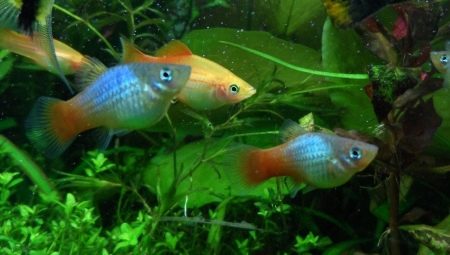Pecilia is an aquarium fish of the Pecilia family. Unpretentious, friendly and peaceful, its content is suitable for beginner aquarists. Fish are viviparous and breed easily, do not cause much trouble to the owners and delight with an unusual varied color. The aquarium with pecilli attracts the eyes, it is interesting to observe the inhabitants.
Description
This fish is a great option for a species aquarium. Pecilia is beautiful and bright, they easily breed and are undemanding to the conditions of detention. Homeland - reservoirs of Central and North America. Wild species look dimmer: the body is pale yellow in color with brown spots. But thanks to the painstaking work of breeders, many decorative breeds of the most incredible shades have been bred. Pecilia, there are more than 30 species. They differ in color, body shape and fins, but they have common signs:
- the size of the speckles is from 4 to 12 cm;
- viviparous;
- may change gender;
- unpretentious;
- live in the aquarium for 3 to 5 years.
The life span of the Pecilia depends on the type and conditions of detention.
Despite survivability, they require care and maintenance.
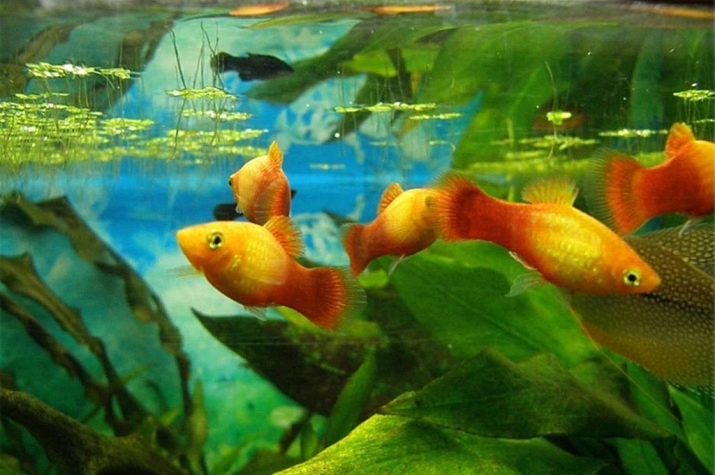
Kinds
Pecilia has many varieties, each breeder will be able to choose fish for everyone. We will consider 12 species that are most often found in an aquarium.
- Cylinder (disk). The fish has a pronounced rounded stomach and a hunched back, the body is short and resembles a keg. Such a structure arose due to a curved spine. Color can be different, there are silver, black, red and spotted individuals.Fish grow up to 10 cm and live no more than 4 years. Because of a curved spine, a balloon in Pecilia more often than in other species has health problems, therefore, it needs good care.
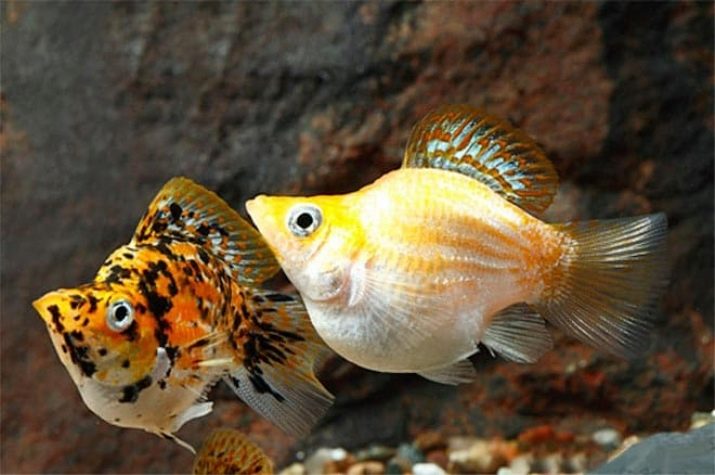
- Radish. A unique feature of this species is a black tail of an unusual shape, elongated in the middle part. Body color is most often red. Pecilia radish is distinguished by endurance and unpretentiousness.
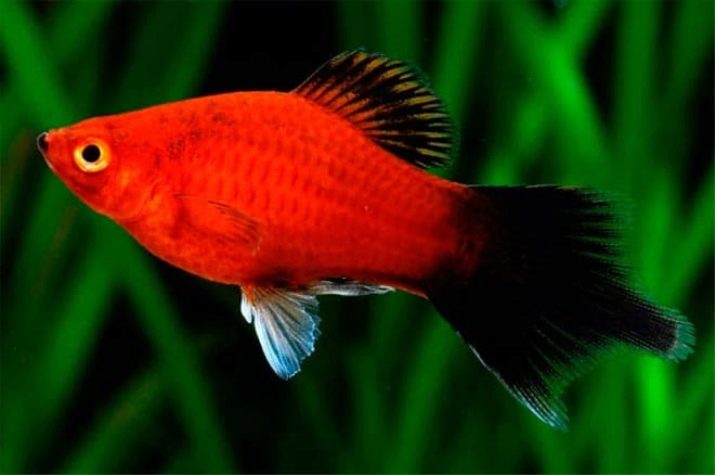
- Black. Active, nimble fish with a peaceful character. The abdomen is black with beautiful iridescent scales, and the fins and head are colored orange. These fish can be crossed with other species and get fry of the original color.

- Three-color. Despite its small size (the fish grows up to 5 cm in length), it requires a lot of space. The aquarium should be planted with dense vegetation in which the fish like to hide. These Pecilia are multicolored, their color consists of a combination of several colors: yellow, green, blue, silver, orange and black.
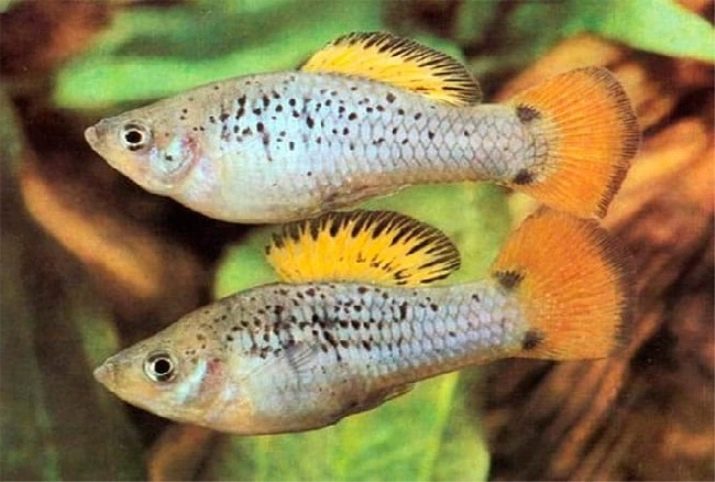
- Sailing Wellife. It features a beautiful large dorsal fin, similar to a sail. The fish can be colored in different ways - there are red, chocolate, silver, black and marble individuals.

- Spotted. This species is the closest to wild fecilli, and they need a spacious deep aquarium. The color is very diverse - more than 30 varieties. Breeders love to contain spotted sandwiches for the reason that by crossing individuals between themselves, you can get fish of various colors.
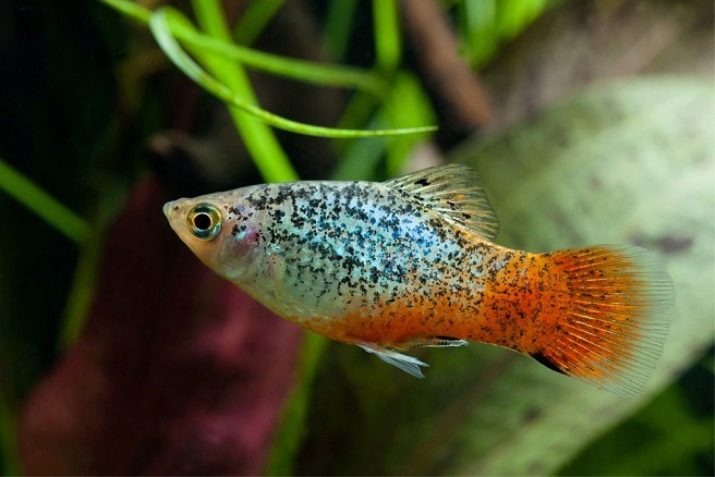
- Yellow. Sunny fish with a yellow abdomen and a bright scarlet tail. In females, the tail fin can only be slightly colored. This Pecilia is unpretentious, different lively and funny character.
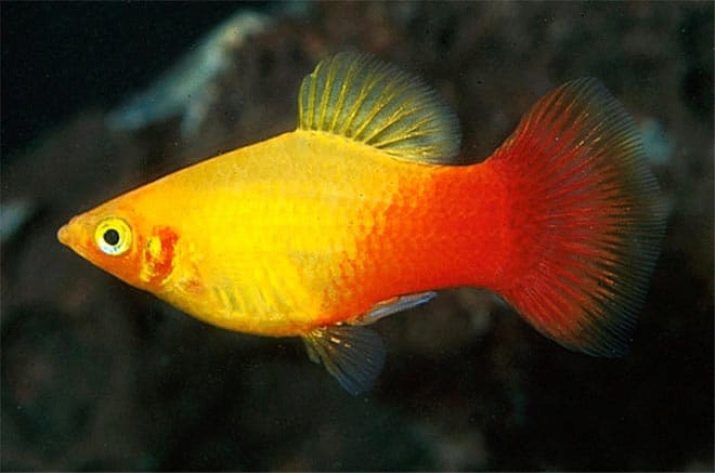
- Rainbow (neon). An individual of this species fascinates with its original color. Silver scales shimmer in the sun with blue, blue and turquoise hues. Schooling fish, so it is better to populate them in a group - 6-10 pieces.
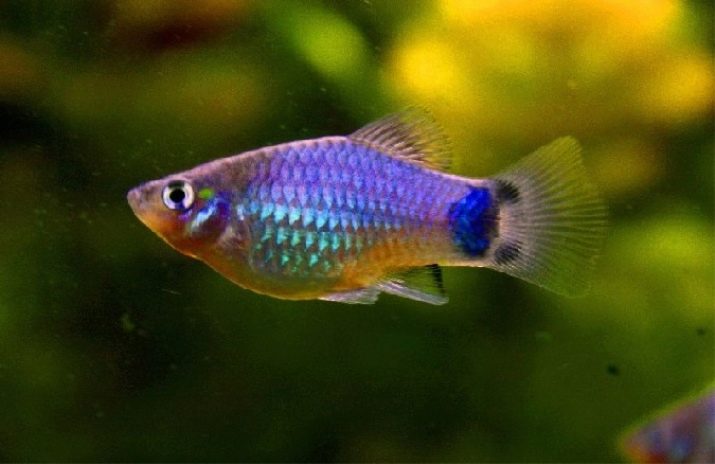
- Black-tailed. In appearance, the fish resembles swordsmen: an orange body and a black tail. They grow large enough for Pecilia - up to 12 cm. This species needs live food more than others.
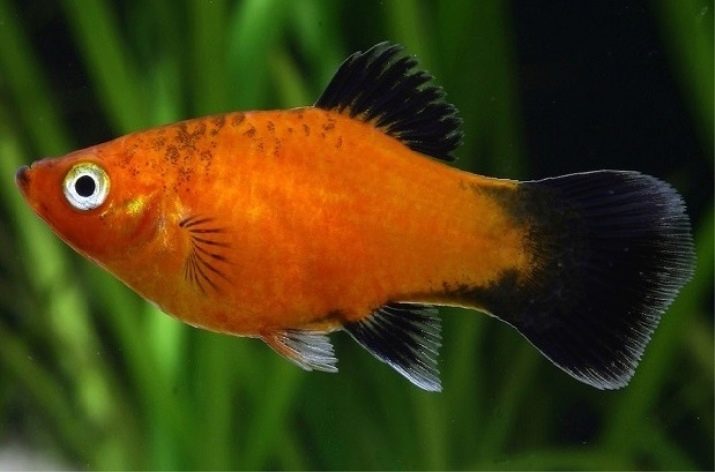
- Mickey Mouse. The fish got its name due to the drawing at the base of the caudal fin: three black spots resemble the head of a cartoon mouse. The color of the body is silver or orange.
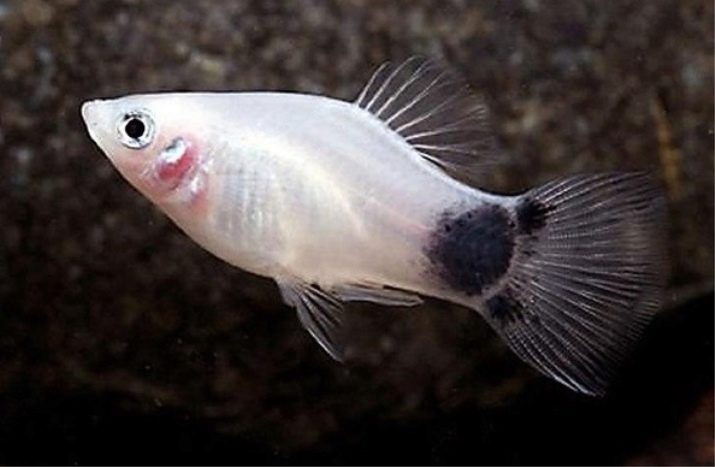
- Sunset Color is heterogeneous: lemon shades smoothly turn into scarlet or bright orange color. On the sides there may be dark specks. In nature, these peculiarities are not found.

- Tuxedo. Fish of silver or red color with large black spots on the sides, merging into a wide strip. They are mobile and peaceful.
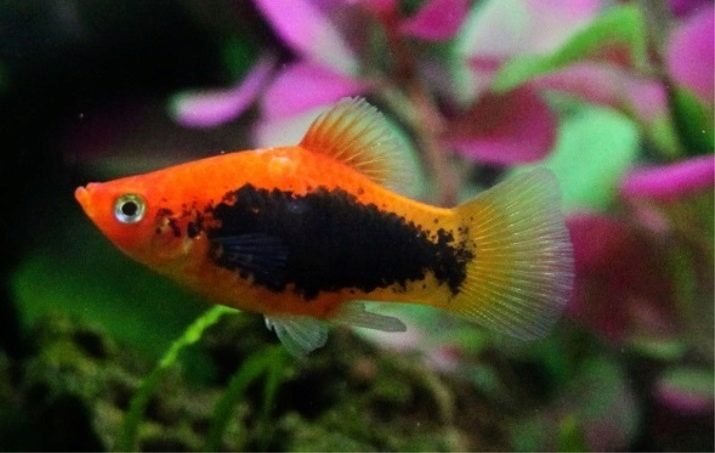
How to choose?
It is better to purchase a fish in a small flock - 4-6 pieces will be enough for the first purchase. Choose healthy individuals:
- the fish must move actively;
- fins are flat, without damage;
- the color of the body is bright, without any growths;
- the body is straight, proportional, with a small tummy, with the exception of the pilgrim balloon, which, as a result of a curved spine, has an unusual shape.
Since Pecilia has a short lifespan, it is better to choose young fish. In order to distinguish adolescents from adults, it is necessary to pay attention to the color: in young animals it is usually paler. Age and fins will tell: in fry they are not so long. When choosing a chicken, take a good look at individuals in bright light. In old fish, scales coarsen, fins are split, the shape of the mouth may change and the eyes become cloudy.
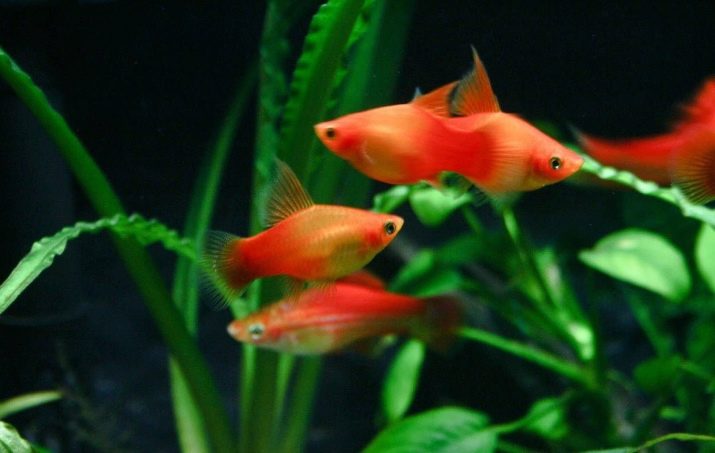
How to distinguish a female from a male?
There are several significant differences between a male and a female, by which you can determine the sex of an individual:
- the color of the males is brighter and richer;
- females are usually larger than males;
- gonopodia is located near the anal fin in males - an elongated genital organ, in a female it is absent;
- females are more pot-bellied, especially if the fish carries fry;
- the dorsal fin of the female is more accurate, it is smaller and narrower than that of the male.
Please note that Pecilia can change sex.This unusual feature of the fish from a scientific point of view is explained by the need for survival and procreation. There are known cases when females as a whole group degenerated into males with changing conditions of care.
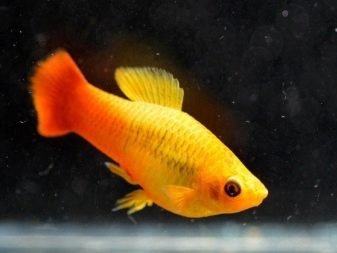
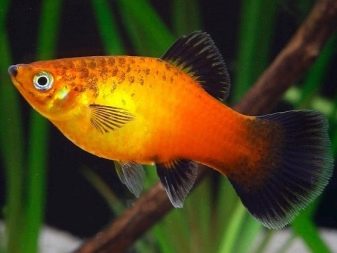
Content Rules
Keeping the pecilli easy, they can even live in 10-liter jars. But still, it is worth considering that for each fish, 1.5–2 liters of water is required. It is best to provide them with an aquarium with a volume of 40 liters or more. Even if the reservoir is small, the main thing is to be deep, as the fish spend most of their life in the middle layer of water.
It is recommended to fill up the dark soil at the bottom - against its background, bright pecilia will look more spectacular. Grottoes and artificial decorations are required - curious fish will be happy to study the surroundings. From plants you can choose:
- cryptocoryne;
- an elodea;
- Wallisneria
- echinodorus;
- riccia;
- hornwort.
Algae is placed along the back wall and on the sides of the tank. A few of any snails are planted in the aquarium that will maintain cleanliness. The container should be closed with a lid, as the fish can jump out of the water. Aeration is necessary only in a densely populated aquarium, but if there are few fish and they have enough space, they are comfortable and without additional oxygen enrichment. Pecilia has enough daylight, artificial lighting is required only if the aquarium is in a dark place.
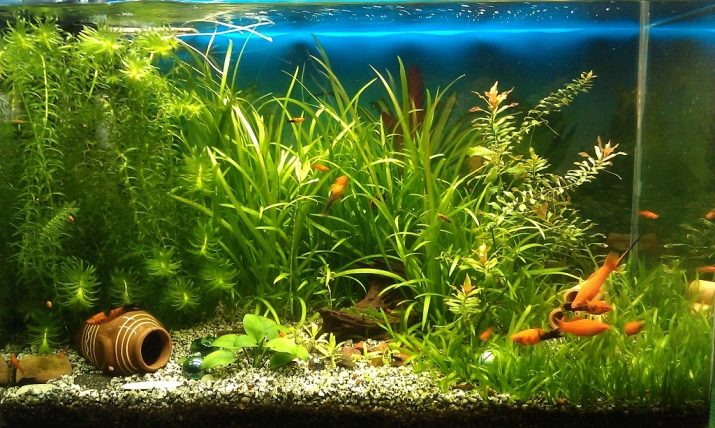
Aquarium Care
The temperature of the water in the aquarium should be maintained in the region of 21-25 degrees. Pecilia is sensitive to water hardness; it should be in the region of 10–30 dH. In too soft water, the fish get sick, so if necessary, use marble chips and a solution of magnesia. These tools increase rigidity.
Partial water changes are required weekly. Using a hose or bucket, pour 20-30% of the liquid into an empty bucket and fill the aquarium with clean, settled water. Complete replacement of the water is not recommended; this can disrupt the microclimate of the aquarium. Such a radical measure is resorted to only in cases of infection of fish with viral and bacterial infections.



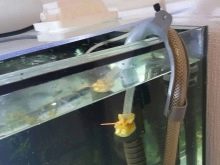
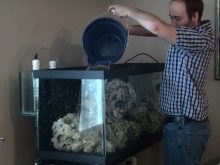
What to feed?
Pecilia are picky and enjoy eating specialized dry food. Fish is fed 2 times a day, in small portions. Flakes containing plant components are preferred. Do not forget about natural feed, you can give:
- bloodworm;
- Artemia
- tubule
- daphnia;
- coretre.
Live food is an excellent source of protein for viviparous fish. It should be purchased only in specialized stores, as it can be a source of the spread of dangerous infections.
If there is any doubt about the quality of the food, then before giving the fish, it should be left for a day in the freezer.
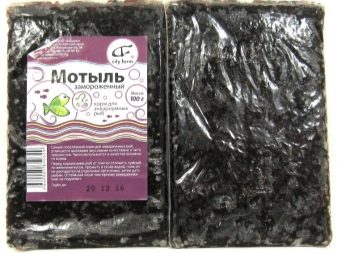
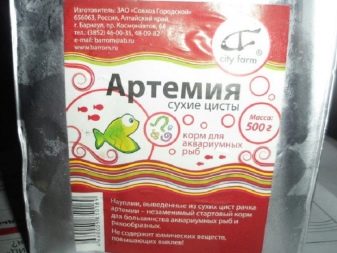
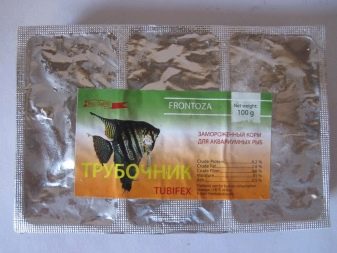
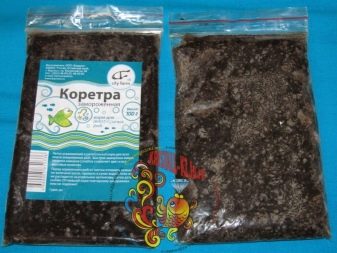
Pecilia should be fed plant foods: cucumber, zucchini, spinach, cabbage and lettuce leaves. First, the vegetables must be washed and scalded with boiling water. Love Pecilia and enjoy the duckweed. The main thing is to clean the remains of food from the aquarium: if a piece of cucumber has not been eaten within 12 hours, it must be removed from the aquarium.
Food particles can rot and cause a bacterial infection.
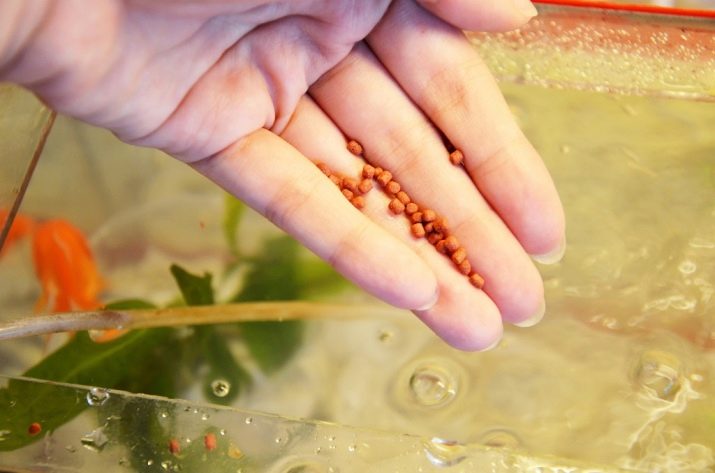
Possible problems
Pecilia is notable for good health, but various ailments do not pass them by. A sick fish lies at the bottom, eats poorly, atypical formations and plaque may appear on the body. The main causes of many diseases are poor care:
- crowded aquarium;
- poor-quality feed and poor diet;
- keeping fish in water that does not meet the required parameters.
Most often, Pecilia is exposed to the following diseases.
- Fungus. It looks like a fluffy coating on the body. Salt will save the fish (100 g per 5 l). Affected individuals are immersed in a saline tank for 20 minutes.
- Fin rot. A sign of infection is turbidity of the fins and their subsequent destruction.At the initial stage of the disease, the fish are treated with salt, and in advanced cases, antibiotics are used.
- White-skinned. It is accompanied by the appearance of white spots on the body, the color of the fish turns pale, the diseased individual keeps near the surface of the water. Infected pecilia is quarantined and treated for five days with chloramphenicol.
To prevent the spread of infections, infections with suspicious, but not clearly expressed symptoms are precipitated from the general aquarium and a therapeutic bath is prepared for them. For this, one tablet of biomycin is dissolved in a 5-liter vessel and the fish is immersed in this medium for 12 hours. Salt is also used for these purposes.
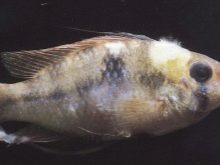
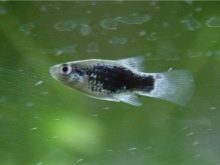

Breeding
Pecilia are viviparous fish and breed well in a common aquarium. The female can bring up to 60 fry. If there are enough shelters in the "water world", then most of the kids survive, the other part can be eaten by adults. Thick algae are the best refuge for young fish. In order to avoid eating offspring, it is better to plant a pregnant individual, for this an ordinary 3-liter jar is suitable. After the appearance of the fry, the female is returned to the aquarium, and the babies are kept there until they grow up.

Many aquarists want unusual hybrid forms with a different color combination. To do this, choose a pair of the most beautiful and healthy fish, whose age is at least 6 months. The female and male must be deposited in a separate tank and create comfortable conditions:
- spawning volume not less than 20 l;
- water temperature is 2-3 degrees higher than in a general aquarium;
- the tank is equipped with an aeration system and good lighting.
After fertilization, the female abdomen is rounded, and a dark spot forms near the anal fin. At this moment, the male is returned to the aquarium. After 4 weeks, fry appear, which begin to swim throughout the space in search of food. The female is planted, and the babies begin to be fed live dust or dry food for fry. They give food often - 5-6 times a day, in small portions. Over time, the frequency of feeding is gradually reduced to 3 times a day.
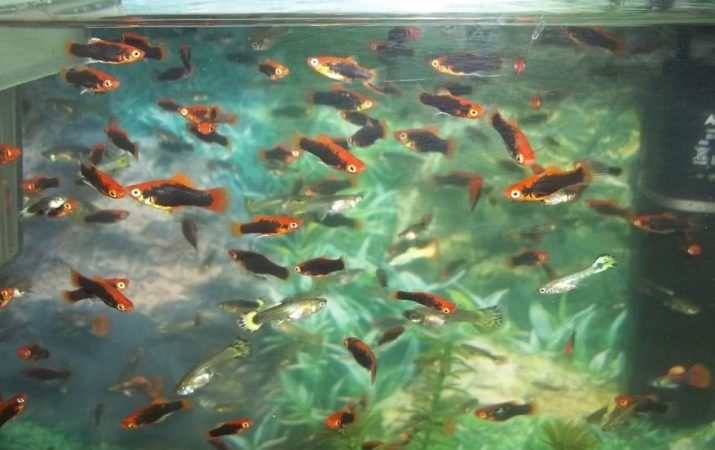
Compatibility
Pecilia, as noted above, is peaceable, they don’t bother the neighbors and get along well with other types of fish:
- guppies;
- cockerels;
- scalaria;
- zebrafish
- tetra;
- barbs;
- iris coasters;
- gourami;
- macropods;
- discus
- swordsmen.
They can not be kept together with cichlids, astronotuses and gold. These aquarium fish will chase defenseless pecilli. Much depends on the individual character traits of individuals, for example, conflict can sometimes arise with swordsmen or barbs. Therefore, when replanting new neighbors, you should first observe the fish for the first time.
When persistent hostility occurs, they are seated or divided into an aquarium with a transparent partition into two zones.
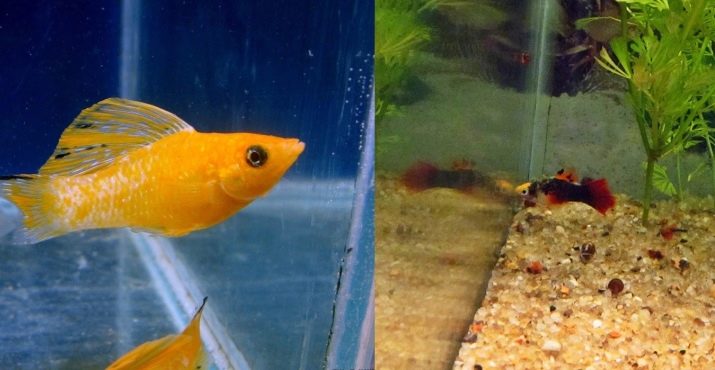
You can see the details in the video below.
